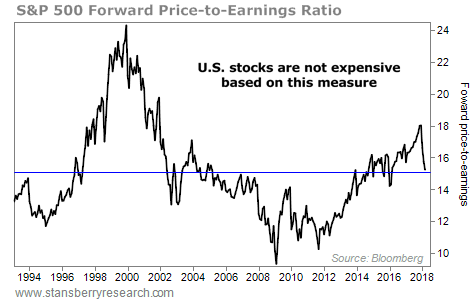| Home | About Us | Resources | Archive | Free Reports | Market Window |
|
Editor's note: The markets will be closed tomorrow in observance of Good Friday. Look for your next issue of DailyWealth on Monday after the Weekend Edition. Enjoy the holiday.
Watch the Lie: Stocks Are No Longer ExpensiveBy
Thursday, March 29, 2018
It's true... Stocks have gone up for nine years in a row.
It's true... Stocks hit all-time record highs earlier this year.
But it's NOT true that stocks are expensive today...
I'm not kidding.
Thanks in part to two things, stocks are not expensive anymore. Let me explain...
Two things directly cut down the main measure of "value" in the stock market – the price-to-earnings ratio...
The price of stocks – the top half of the ratio – went down in the correction. Meanwhile, earnings – the bottom half of the ratio – are expected to go up dramatically, largely thanks to the tax cuts. (Over the next 12 months, the earnings of companies in the S&P 500 Index are expected to rise by 27%.)
Both the numerator and the denominator in the world's main measure of value have improved dramatically – in a short amount of time.
So contrary to what you might think, or what you might be hearing in the media, stocks are no longer expensive.
Specifically, the price-to-earnings ratio has now fallen exactly in line with its 25-year average. (This is based on next year's estimated earnings, to include the impact of the tax cuts.) Take a look...
 You can easily see the great peak in valuations around the time of the dot-com frenzy. Stocks were the most expensive they've been in the last 25 years. (Actually, ever.) And you can easily see the great bottom in valuations in 2009. Stocks were the cheapest they've been in the last 25 years.
So what does this measure of stock market value tell us now?
Today, we are exactly in the middle... Stocks are trading right at their average valuation over the last 25 years. They are not cheap – but they're not expensive.
Keep in mind, this is looking at earnings estimates for the next year. If you only look in the rearview mirror at trailing earnings, you will come to a different conclusion today.
These forward earnings estimates aren't guaranteed to come true. However, I want to make decisions based on all available information, not just based on looking in the rearview mirror.
I'm sure you can list plenty of reasons why stocks could keep falling. But now you'll have to take the main measure of value off your list...
Prices have fallen. Earnings are rising. Therefore, the price-to-earnings ratio is much lower today than it was at the start of this year.
Can stocks soar from today's valuation?
Absolutely! It happened just a couple of years ago...
Stocks are now trading at the same forward P/E ratio they were trading for in March 2016. The S&P 500 soared 46% (in total return) between then and January this year. That's 46% in less than two years... from the same starting point in valuation we have today.
As of today, stocks are neither expensive nor cheap, based on the most classic measure value.
Don't let 'em tell you any different... And don't let valuation be the reason that you are not invested. That reason is now no longer valid...
Good investing,
Steve
Further Reading:
"You should root for corrections to happen more often," Dave Eifrig writes. Most investors cheer when the market rises and panic when it falls. But small pullbacks can come with a silver lining. Read more here: Exactly How You Should Trade the Next Market Correction.
"Value investing works, AND momentum investing works," Steve says. Learn more about how to use these two strategies right here: How to 'Call' the Markets Correctly.
Market NotesTHIS COMPANY IS DEFYING THE 'DEATH OF RETAIL' Today's chart shows how one brick-and-mortar company has seized a competitive edge...
"Retail isn't dying," according to Business Insider, "it's evolving." And while many traditional retailers are struggling as e-commerce takes over, some are bucking the trend. Today, we can see this with discount retailer Burlington Stores (BURL)...
Burlington once relied on its brand-name coats to bring strong winter sales. But in recent years, the company has expanded its business into handbags, accessories, and home goods. Now, it's a "one-stop shop," not unlike online-retail giant Amazon (AMZN). In 2016, as global e-commerce sales hit a record $1.8 trillion, Burlington joined the Fortune 500 – the largest U.S. companies by total revenue. And its new strategy is still working today... Total revenue increased 9% in 2017, and it's projected to increase another 9%-10% this year.
As you can see below, Burlington's stock is soaring as well. Shares recently hit a new all-time high, after climbing around 141% over the past two years alone. It looks like the "one-stop shop" model can work for physical retailers, too...
 |
Recent Articles
|



